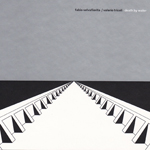|
|
 |
Dusted Reviews
Artist: Fabio Selvafiorita and Valerio Tricoli Album: Death by Water Label: Die Schachtel Review date: Oct. 31, 2011 |

|
|
|
 |
Much of Death by Water feels like it comes from another era. The title is taken from a cornerstone of Modernist poetry, T.S. Eliot’s The Wasteland. All the sounds were recorded on reel-to-reel tape machines on Giudecca Island in Venice and subjected to live tape treatments. It runs for nearly 40 minutes, a length more suited for the concert hall or a classic tape music concert rather than the shuffled playlist of the Internet era. In short, this should be a piece from another era, its high-concept framing akin to an INA-GRM project and the handcrafted detail like a Tod Dockstader work.
But Valerio Tricoli and Fabio Selvafiorita are very much contemporary. Selvafiorita is a serious scholar of electronic,computer and experimental musics, while Tricoli is just at home producing avant-rock records for Dean Roberts or 3/4 Had Been Eliminated as he is improvising and composing with Thomas Ankersmit. With Death by Water they’ve created a masterful display of musique concrète, but tactile work might be closer to the truth, as this work is more about effect than genre. The sounds have a graininess, a mottled touch that pops out of the speakers. High hissing frequencies carry as much as weight as the booming wind-tunnel lows. The chattering, clicking cross-hatching of machine rhythm that appears is as much mechanical as it is rhythmic. We’re feeling the music as much as we’re hearing it.
Aside form this textural unity, however, detecting a narrative arc is next to impossible. Very few sounds and passages repeat, if any do, and so the listener is left to imagine connections, to piece together and suss out the origin of, say, the bits of singing that emerge or the glimpses of water and air that move the cracks in the work’s surface. Despite the piece’s very specific site of recording, the sense of place is tenuous. Space is present, mostly in the shifts of fidelity that appear surprisingly and the soft patina of reverb that hangs nearly everywhere. The sense of the aquatic derives equally from the queasy wobble of tape being manipulated on heads as it does from the field captures of actual water. As a listener you’re left to hang with very little direct references.
This dynamic between the recording and the recording device, the specific and the abstract, the real and the created, helps us understand why the duo would choose Eliot’s poem as a framing device. The poem, too, is a re-mediation of memory and perception, a way of replacing listener/reader experience with something outside that experience. What you know doesn’t necessarily help you. This is why people find “The Waste Land” difficult, and it’s why they will feel the same about Death by Water. Yes, it’s hard to continually have to puzzle out these sonic connections, just as tracking the allusions in Eliot’s poem can seem tedious at times. If it seems limiting, that’s because it’s supposed to. It requires hard work. And if hard work in understanding and appreciating anything, let alone a piece of poetry or music, is also something that seems like it comes from another era, then we’re in big trouble.
By Matthew Wuethrich
|







